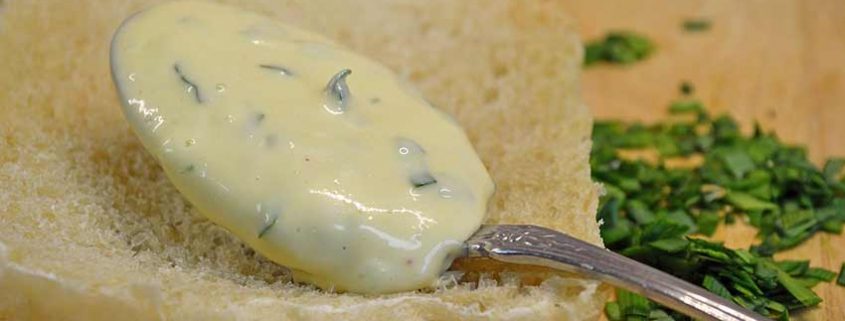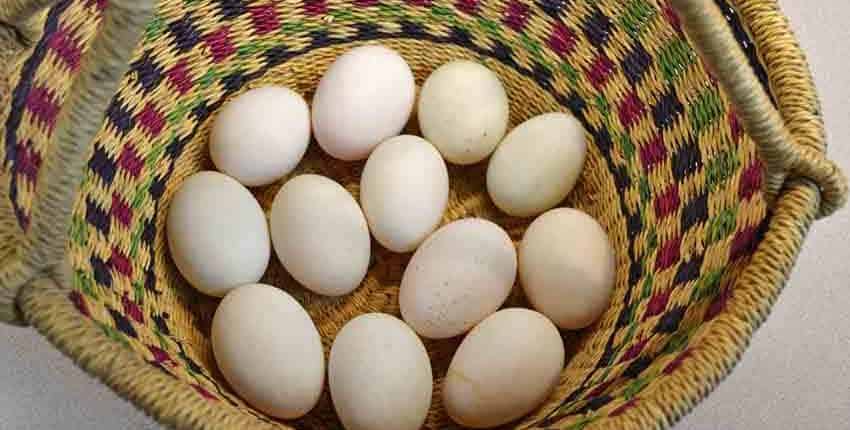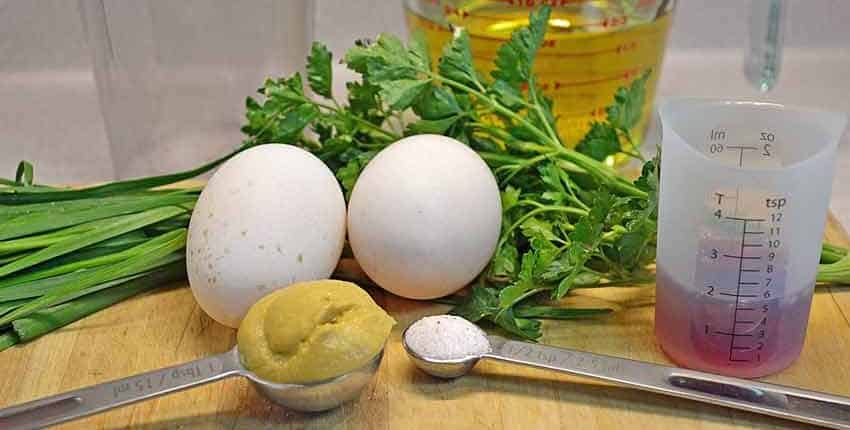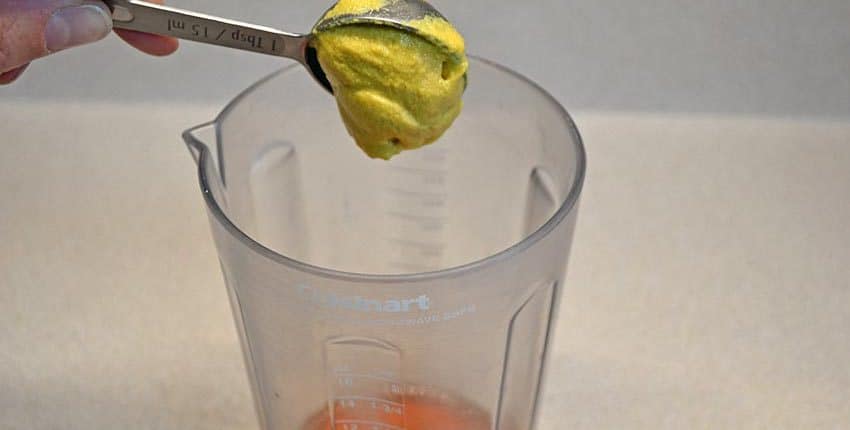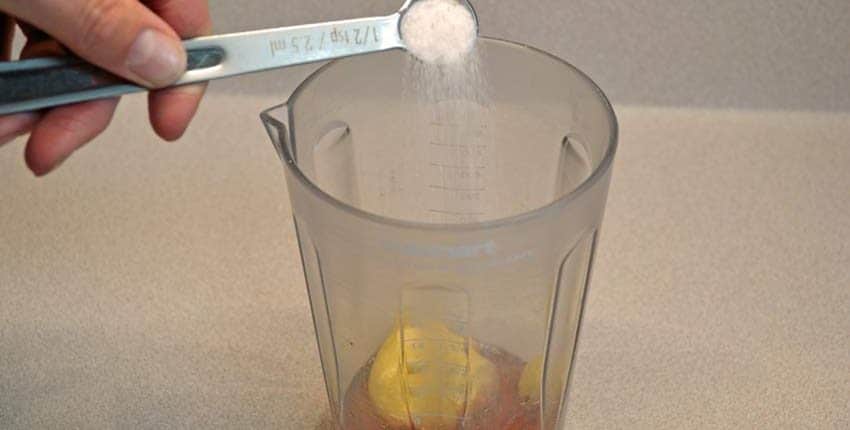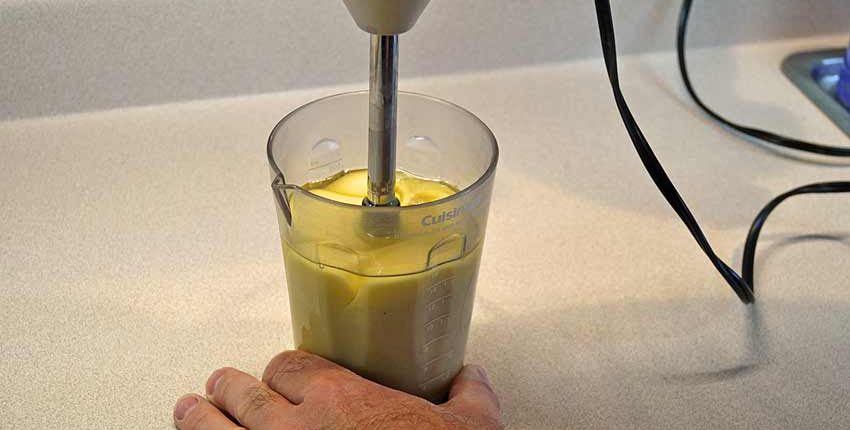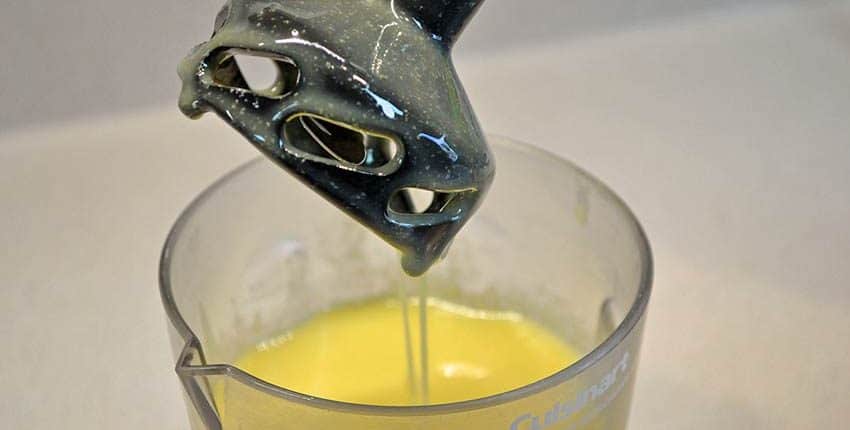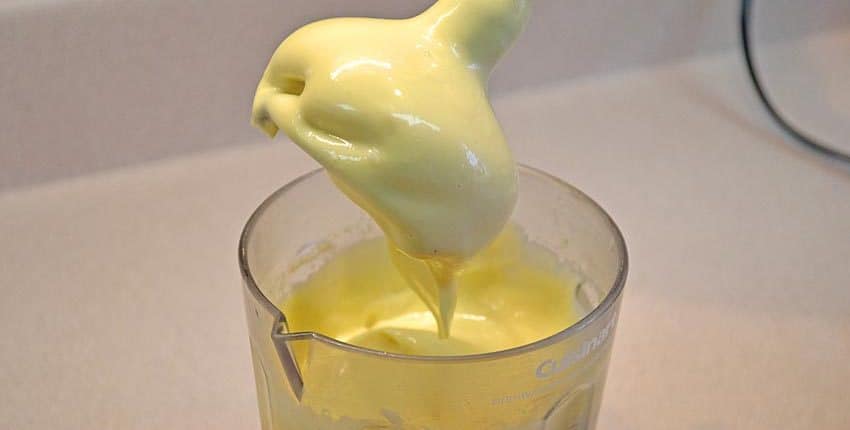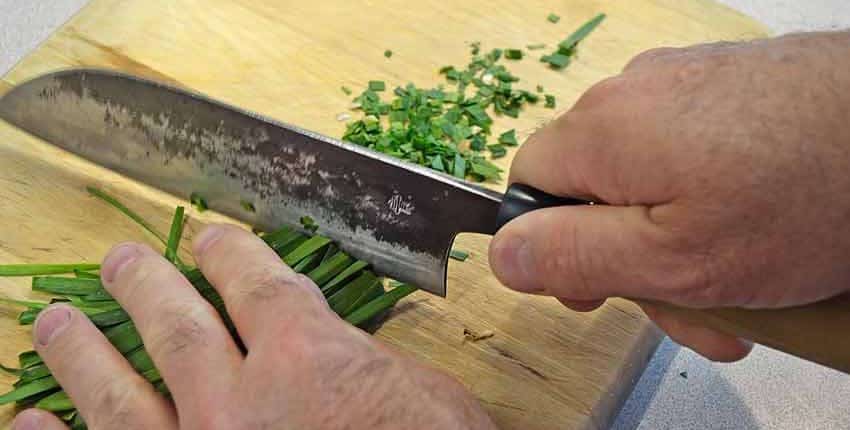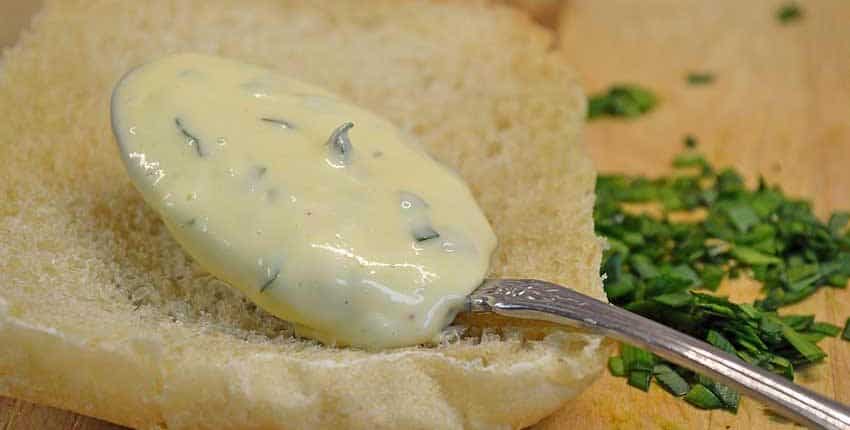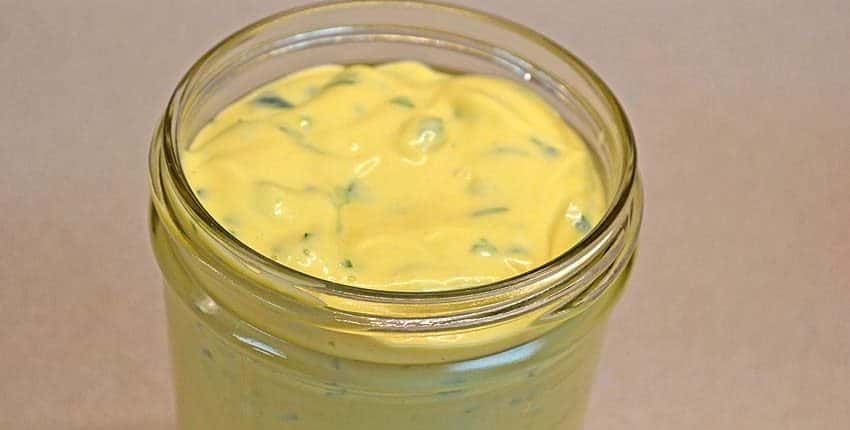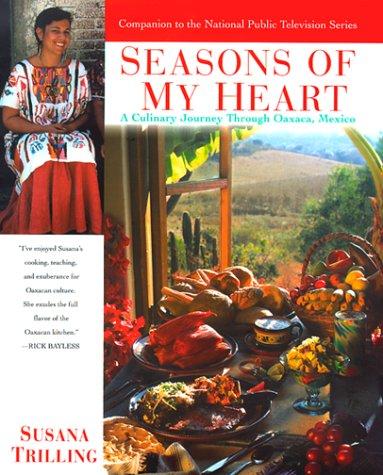Elevate your coleslaw game with Chipotle-Cilantro Coleslaw. This recipe features roasted golden beets for a unique and delicious twist.
Tag Archive for: Garlic Chive
Real, traditional mayonnaise has only five simple ingredients but is rarely made fresh, which is truly a shame. Discover how to make fresh delicious mayonnaise in 30 seconds with our recipe, and don’t worry about running out of the store-bought stuff ever again! Once you’ve tasted what real, fresh, homemade mayo is all about and explore the flavor variations, you’ll wonder why you didn’t ditch the jar sooner.
Fresh Food Warning
Unfortunately in today’s world of industrial, factory farmed foods, we must let you know that there is a risk of illness if using commercially produced eggs. That’s why we strongly recommend using fresh eggs from your own or a friend’s backyard chickens or ducks – you know exactly what conditions the eggs come from! Fresh farmer’s market eggs from a producer you know and trust is a good second choice, with certified organic eggs from a store being a third one.
What to do with all these eggs?
More often than not, if you, your neighbor or a friend have chickens or ducks in the backyard, sooner or later you’ll wind up with a surplus of eggs. There are lots of ways to use excess eggs, but we’ll show you one approach that will make your taste buds sit up and sing!
Here’s a peek into our egg basket after a normal spring morning of collecting duck eggs. We currently have Khaki Campbells and are expecting Welsh Halequins, both of which are excellent layers with great tasting eggs and no gamey flavors.
We’ll walk through the process after the recipe:
- 1 1/2 tsp red or white wine vinegar
- 1 tbsp Dijon mustard
- 1/2 tsp sea salt
- 1 egg - fresh is essential for flavor a second may be needed
- 1 1/2 cups high quality oil - avocado sunflower, canola, olive are all good
- Finely chopped herbs of your choice - optional
- Add ingredients into immersion blender cup in order listed.
- Lower immersion blender into bottom of cup.
- Puree for 3 seconds at bottom, then slowly bring to top while blending and emulsifying the oil - about 15 - 20 seconds.
- If mayonnaise is too thin, remove blender and add second egg. Repeat blending from bottom to top of cup.
- Once desired consistency is reached, add chopped herbs or spices and blend for 5 - 10 seconds.
- Store in a glass container and refrigerate for up to one month.
Making Mayonnaise the Easy Way
Start with gathering all of the ingredients – for the mayonnaise you’ll need eggs, a high quality oil, vinegar, salt and mustard. No emulsifiers, preservatives, thickening agents or ingredients you cannot easily pronounce. You can start with the very basic – and classic – version without herbs or spices and then expand your tastes as you like. Or, if you are a bit more adventurous and want more flavor than what comes out of a jar, then try some fresh herbs from your garden, or a dried herb mixture such as Herbes de Provence!
We chose to add garlic chives and parsley to our mayonnaise, simply because they were both growing vigorously in our container herb planters and were close at hand.
Red wine vinegar was our choice for the flavor, but white wine vinegar or apple cider vinegar are also great choices. Each will have a different flavor, so you can experiment and see what you like best! You might find you have a favorite mayonnaise for certain foods, and another recipe for others.
Dijon mustard is next, and the same advice applies. Test different mustards for their textures, flavors and aromas they contribute to the finished mayonnaise and decide what you like!
We use a Himalayan pink salt, but there are several different sea salts or RealSalt from Utah that would be good. A natural salt contributes a better flavor.
Next in is the duck egg, or chicken egg. Make sure to have a second one in reserve – we’ll show you why in just a minute! Different types of eggs will have different flavors, so if you have chickens you might try a duck egg mayonnaise, or vice versa.
Avocado oil is what we used in this recipe as it has a nice mellow flavor that supports but doesn’t dominate the mayonnaise. Again, do some testing and try different oils to see what you and your family like.
You’ll notice this is taking place in a simple Cuisinart immersion blender cup. This is the secret to the 30 seconds, as it does away with the dribbling oil into a blender or food processor. You simply add the ingredients…
…and insert the immersion blender all the way to the bottom of the cup before turning it on. Ours has two speeds, so I will start the process on low to puree the egg and solids at the bottom for 3 – 5 seconds, then switch to high as I slowly pull it upwards. You’ll see the emulsification process taking place as the blender works its way upwards.
If you get to the top of the cup and see the mayonnaise is too thin for your liking – don’t worry! Set the blender aside and add that second egg. It will go to the bottom, so repeat the blender at the bottom on low, switching to high as you pull it upwards. You’ll see the same process taking place, but the mayonnaise will be much thicker this time.
This is what the difference the second egg makes. This reminds me of the fresh made mayonnaise I used to enjoy in Belgium with fresh hot french fries, lightly salted and sprinkled with paprika. In much of Europe, french fries (called frites) are mostly eaten with fresh mayonnaise as a dipping sauce, or with mustard. Ketchup was unusual, and a sure sign that you are a foreigner!
I quickly came to realize the perfect marriage of flavors of the fresh mayonnaise and hot, slightly salty fries.
The garlic chives are fairly finely chopped, along with the parsley. I wanted a bit more of a chunky texture, but you can make it smoother with a more finely diced or minced herb mixture.
The herbs are added and the blender does its magic again!
The result is a creamy, thick and luscious mayonnaise with an aroma and flavor that you will love! After a taste or two, you will understand the vast difference in flavors from this to the store-bought varieties.
To store, simply scoop into a glass jar. The recipe above will yield enough for a pint plus a little bit more for tasting. Store in the refrigerator for up to a month, but we’ve never had it last nearly that long!
As easy as it is to make, whip up a couple of different versions for sandwiches, or for french fries, or to add on top of a steak – try olive oil and rosemary for that one!
Once you make a couple of versions, let us know which one you like best and what you use it for in the comments below!
Oaxan Sopa de Tomate con Albondigas
One of my favorite Mexican cookbooks is titled Seasons of My Heart, by Susana Trilling. Susana was a chef and owner of a restaurant in New York City and also owned a very successful catering business. She left all of this to pursue her ethnic roots in Mexico around Oaxaca, sharing the food, culture and traditions of the cooking of the region. She wrote this cookbook to showcase the native foods that are not well known outside the region. Seasons of My Hearthas become hard to find but is well worth pursuing once you do find it.
Today I’m going to share a recipe called Albóndigas, or meatball soup. Many people are familiar with Albóndigas as a clear broth with a couple of meatballs in it as an appetizer or first course. This particular soup is more rural in nature, with the broth enriched by the onions and tomato puree. Many people are are amazed to find that this is “Mexican food”, as it doesn’t have the characteristic emphasis on chiles and heat that most Americans are accustomed to seeing in Mexican food. This is one of those perfect hearty winter soups that has an abundance of rich and savory flavors. Make extra, as this soup keeps exceptionally well and will prove to be very popular.
Oaxan Sopa de Tomate con Albóndigas
For the meatballs:
- 1 1/4 pounds ground sirloin
- 1 teaspoon freshly ground black pepper
- 1/2 teaspoon salt
- 1/4 cup sunflower or vegetable oil
- 1 teaspoon mild chile powder
- 1 teaspoon ground cumin
For the soup:
- 4 cups beef stock
- 1 1/2 medium white onions, finely chopped
- One large leek, halved lengthwise and thinly sliced
- 1 tablespoon finely chopped garlic
- 1 1/2 teaspoons ground black pepper
- 3 bay leaves
- 5 cups thick tomato puree
- 1 1/2 teaspoons salt
- 1 tablespoon finely chopped fresh parsley
- 1 tablespoon finely chopped garlic chives
- In a medium bowl, mix the ground beef with the pepper, salt, cumin and chili powder.
- Shape the mixture into tiny meatballs about the size of black cherries.
- In a heavy 4 quart stockpot, heat the oil over medium to high heat and brown the meat balls on all sides, for about 2 minutes, in small batches without crowding them.
- Remove from the pan and set aside.
- If there is extra oil in the stock pot, remove it, leaving about 2 tablespoons.
- Fry the onions and leek until they’re soft over medium heat, 4 to 6 minutes.
- Add the garlic and season with the pepper and bay leaves.
- And the beef broth, tomato puree, and meatballs.
- Lower the heat to a slow simmer, cover, and cook for 1 1/2 hours.
- Add the salt, parsley and chives and cook 5 to 10 minutes longer.
- Serve with garlic toast.
During the winter months, or cold weather, this is the type of soup that is very easy to make when you’re cooking out of your freezer with ingredients that you have prepared beforehand. Making beef broth or beef stock is somewhat time consuming, but does not require constant attention and can be made in large batches, saving time later on. Likewise, making tomato puree from extra tomatoes when your garden is in the height of production gives you a rich, fresh tomato taste in the dead of winter.
Please give this soup a try, and let us know what you think!

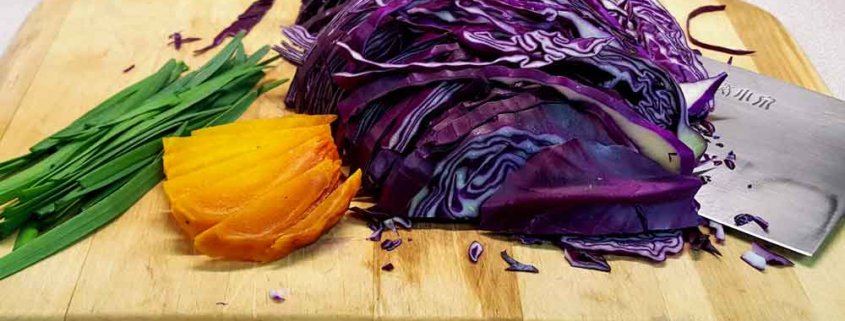 © 2024 Terroir Seeds | Underwood Gardens
© 2024 Terroir Seeds | Underwood Gardens